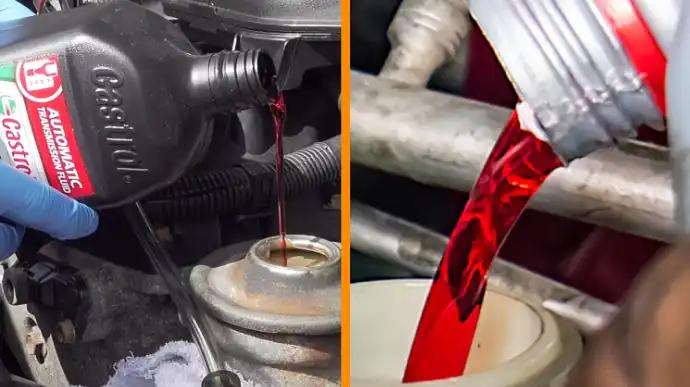Physical Address
304 North Cardinal St.
Dorchester Center, MA 02124
Physical Address
304 North Cardinal St.
Dorchester Center, MA 02124

Understanding the differences between power steering fluid and transmission fluid is crucial for maintaining the optimal performance and longevity of your vehicle. These two distinct fluids play essential roles in a car’s power steering and transmission systems, and their unique properties and purposes set them apart.
Power steering fluid acts as a hydraulic medium in the power steering system, while transmission fluid is formulated specifically for the transmission system. Due to additives and conditioners, the power steering fluid is typically clear or light amber, while the transmission fluid is usually red or brown.
Here, we’ll explore the differences between power steering fluid and transmission fluid for your vehicle. From understanding the true nature of transmission fluid to the importance of fresh power steering fluid, we’ll unpack the technicalities.

When comparing power steering fluid and transmission fluid for your vehicle, there are several key differences to consider.
Power steering fluid primarily provides hydraulic pressure to the power steering system. It lubricates the steering system and reduces the effort required to turn the wheels.
On the other hand, transmission fluids are designed specifically for transmissions. It serves multiple purposes, including lubricating gears, cooling the transmission, and transferring power from the engine to the wheels.
Considering their distinct demands and characteristics is the key to understanding the viscosity and appearance of power steering and transmission fluids.
Power steering fluid typically has a higher viscosity compared to transmission fluid. This is because power steering systems require a thicker fluid to provide the necessary hydraulic pressure for steering assistance.
In terms of appearance, power steering fluid can appear as clear or light amber, depending on the manufacturer and specific requirements.
Alternatively, transmission fluid has a thinner consistency and often appears red or brown. This coloration is due to the additives and conditioners present in the fluid to enhance its lubricating and cooling properties.
Using the correct fluid for your vehicle’s power steering system is crucial for ensuring compatibility and optimal performance.
While some vehicle models, like those from Ford, Chrysler, and GM, may use transmission fluid for their power steering systems, others, such as Honda and Acura, require unique power steering fluids.
This variation in fluid requirements highlights the importance of consulting your vehicle’s user manual or contacting the manufacturer to determine the correct fluid for your specific make and model.
Failure to use the recommended fluid can lead to compatibility issues, which may result in damage to the power steering system and compromised performance.
Therefore, it’s essential to ensure that the fluid you choose is compatible with your vehicle’s power steering system to maintain its functionality and longevity.
When choosing between power steering and transmission fluids for your vehicle, you should consider the additives and detergents present.
Transmission fluid is formulated with specific additives and detergents that serve various purposes. These additives protect the transmission system by reducing friction among moving parts, preventing wear and tear, and combating extreme temperatures.
In contrast, power steering fluid typically lacks these additives and detergents. Its primary function is to optimize power transfer in the steering system, reducing steering effort.
Transmission fluid plays a crucial role in cooling the transmission system. It’s designed to transfer heat away from the transmission components, preventing overheating and ensuring optimal performance.
Additionally, transmission fluid acts as a cleaning agent by capturing and suspending harmful debris, preventing it from causing damage to the transmission system.
On the other hand, power steering fluid isn’t primarily designed for cooling or cleaning purposes. Its main function is to provide lubrication and hydraulic assistance to the steering system, ensuring smooth and responsive steering.
Therefore, while transmission fluid focuses on cooling and cleaning, power steering fluid prioritizes lubrication and hydraulic assistance.
Transmission fluid is specifically formulated to endure the intense heat generated by the transmission system during operation. This is because the transmission system operates at higher temperatures than the power steering system.
Conversely, power steering fluid doesn’t require the same heat tolerance level since the steering system generally operates at lower temperatures.
The distinct formulations of these fluids are designed to cater to the different thermal demands of their respective systems. This ensures optimal performance and prevents overheating, which can lead to damage and malfunction.
The handling of pressure and vibration differs between power steering fluid and transmission fluid for vehicles. Transmission systems typically operate under higher pressures and experience more vibrations due to the dynamic nature of gear shifting.
As a result, transmission fluid is formulated to withstand these demanding conditions. It contains additives that provide enhanced lubrication and protection against wear and tear caused by high pressures and vibrations.
Meanwhile, power steering systems operate under lower pressure and experience fewer vibrations. Power steering fluid is designed to match these conditions, optimizing the ease of steering. It has a lower viscosity to allow for smoother flow and reduce the strain on the power steering system components.

Power steering fluid typically needs to be replaced every 5 years or every 40,000 to 80,000 miles, depending on the manufacturer’s recommendations and the type of fluid used. Power steering systems operate at lower temperatures and don’t experience as much wear as transmissions.
On the other hand, transmission fluid generally requires more frequent changes, typically every 30,000 to 60,000 miles, following the manufacturer’s schedule. This is due to the higher temperatures and greater stress that transmissions endure.
You should follow a specific fluid change procedure when replacing the power steering fluid or transmission fluid in your vehicle.
Changing power steering fluid is generally a simpler process compared to changing transmission fluid. For power steering fluid, start by draining the existing fluid from the reservoir. Then, add the recommended fluid into the vehicle, making sure to use the correct type and quantity specified by the manufacturer.
Then again, changing transmission fluid involves more extensive steps. This may include a complete fluid flush or fluid pan drop, replacing the filter, and carefully following the manufacturer’s specifications.
| Aspect | Power Steering Fluid | Transmission Fluid |
| Composition and Function | Provides hydraulic pressure for steering assistance, lubricates steering system, reduces effort to turn wheels | Lubricates gears, cools transmission, transfers power from engine to wheels |
| Viscosity and Appearance | Higher viscosity, clear or light amber appearance | Thinner consistency, red or brown appearance due to additives and conditioners |
| Vehicle Compatibility | Varies by vehicle make and model, some use transmission fluid (e.g., Ford, Chrysler, GM), others require unique power steering fluids (e.g., Honda, Acura) | Varies by vehicle make and model, typically specified in the user manual |
| Additives and Detergents | Lacks specific additives and detergents, focuses on power transfer optimization | Formulated with additives and detergents to reduce friction, prevent wear, and combat extreme temperatures |
| Cooling and Cleaning | Primarily for lubrication and hydraulic assistance, not designed for cooling or cleaning purposes | Cools transmission system by transferring heat away, acts as a cleaning agent by capturing and suspending debris |
| Heat Tolerance | Lower heat tolerance, designed for lower operating temperatures in power steering systems | Higher heat tolerance, formulated to endure intense heat generated by transmission system |
| Handling of Pressure and Vibration | Operates under lower pressure and experiences fewer vibrations, lower viscosity for smoother flow | Formulated to withstand higher pressures and vibrations in transmission systems |
| Fluid Replacement Frequency | Typically replaced every 5 years or 40,000-80,000 miles | Typically replaced every 30,000-60,000 miles, more frequent changes due to higher temperatures and stress |
| Fluid Change Procedure | Generally simpler process, drain existing fluid, add recommended fluid specified by manufacturer | Involves more extensive steps, may include fluid flush, pan drop, filter replacement, follows manufacturer’s specifications |
Transmission fluid isn’t referred to as oil. Although transmission fluid and engine oil serve different purposes in a vehicle, they’re often mistaken for one another due to their similar appearance.
It’s important to understand that transmission fluid and oil are distinct substances with different compositions and functions. While oil lubricates and cools the engine, transmission fluid is a hydraulic fluid that enables smooth gear changes and protects the gears and clutches from friction.
Transmission fluid has a higher viscosity than oil and is typically a deep red color. It’s crucial to use the correct fluid type in your vehicle’s transmission to ensure optimal performance and longevity.
For the transmission system to perform efficiently and last long, specific additives, such as friction modifiers and detergents, are necessary. Wear and tear on metal components can be prevented by these additives, since they reduce friction between moving parts.
Additionally, the detergents in transmission fluid are designed to carry away contaminants, ensuring a cleaner and more efficient system. In contrast, power steering fluid lacks these essential modifiers and detergents, making it less effective at providing the same protection and performance.
Using water instead of power steering fluid isn’t recommended due to its lack of essential properties and potential damage to steering components.
Power steering fluid is specifically designed to meet the requirements of the power steering system, providing lubrication, heat dissipation, and corrosion protection. Conversely, water lacks these necessary properties and can lead to decreased power delivery through the system over time.
Additionally, water is corrosive and can cause damage to the various components of the steering system, including seals, hoses, and the pump. It’s important to use the recommended power steering fluid to ensure the proper functioning and longevity of the steering system.

If your power steering fluid is old, you may notice decreased steering performance. As the fluid ages, it can lose its lubricating properties, resulting in increased friction within the system. This can make the steering feel stiff or sluggish, requiring more effort to turn the wheel.
Another symptom of old power steering fluid is increased noise when turning the wheel. This could be due to air bubbles or contaminants in the fluid, causing the pump to work harder and produce unusual sounds.
Additionally, old power steering fluid may appear darker in color and have a burnt smell. This indicates that the fluid has become contaminated and may no longer effectively lubricate and protect the components of the power steering system.
Understanding the differences between power steering and transmission fluids is crucial for vehicle maintenance.
Each fluid has its specific role, composition, and requirements, and using the wrong one can lead to costly repairs and potential damage to your vehicle. Whether it’s the viscosity, additives, or heat tolerance, these distinctions matter.
While transmission fluid is often referred to as oil, it isn’t necessarily better than power steering fluid. And replacing power steering fluid with water is not recommended as it can cause damage to the system.
To keep your power steering system performing at its best and to avoid costly repairs, you should monitor the symptoms of old power steering fluid.